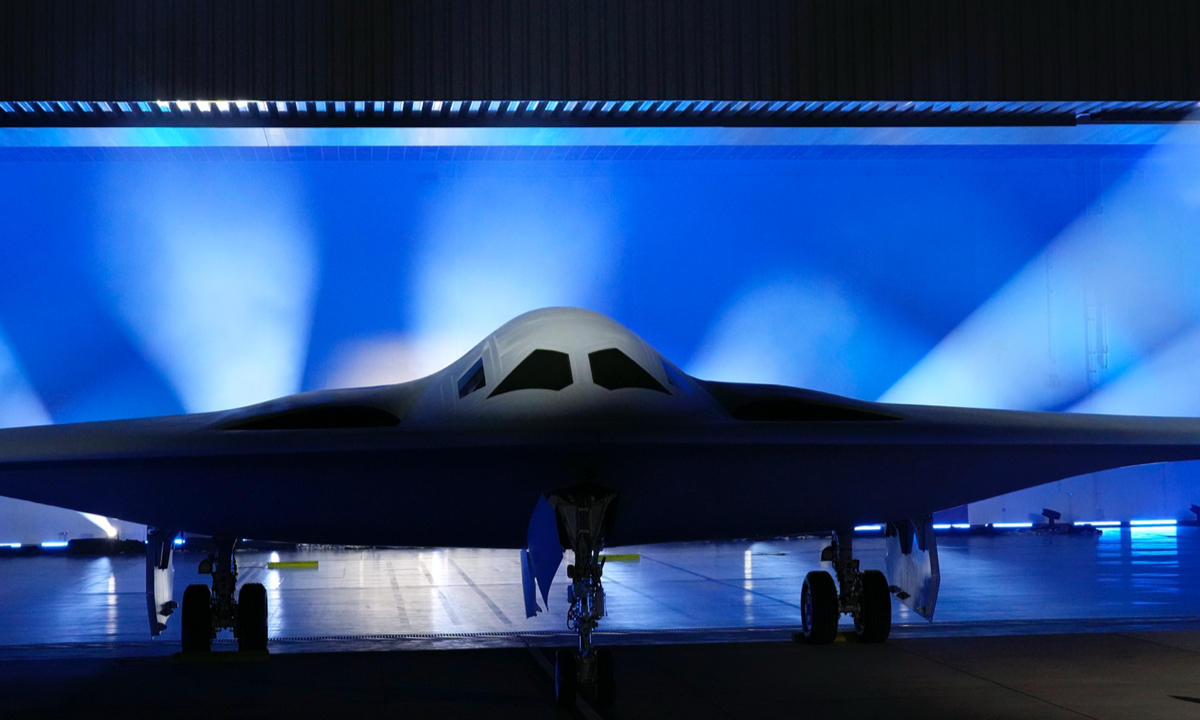
The B-21 Raider stealth bomber is unveiled at Northrop Grumman on December 2, 2022, in Palmdale, California, the US. It is the first new American bomber aircraft in more than 30 years. Photo: VCG
The world finally got its first glimpse on the B-21, the US' first new bomber in more than 30 years, after it made a high-profile debut in a ceremony on Friday, an event analysts said on Sunday is an attempt to flex its muscles and deter China.
Inheriting some selected strengths and drawing on lessons from major shortcomings of the B-2, the B-21's powerful but expensive predecessor, the new stealth bomber can be mass-produced and is more pragmatic in major power competitions, posing new challenges to the national defense of China, which is reportedly also developing a next-generation bomber of its own, Chinese experts said.
Held in the US Air Force's Plant 42 in Palmdale, California on Friday, the event saw the B-21 towed out of a hangar as the aircraft made its debut.
US Secretary of Defense Lloyd Austin said at the event that the bomber, in development for seven years, has a long range that makes it does not need to be based in theater and a stealth capacity that means sophisticated air defense systems will struggle to detect it.
The B-21 is easy to maintain, and it can deliver both conventional and nuclear munitions, is built with an open-system architecture which makes it highly adaptable, and it can also carry out intelligence gathering and battle management missions, according to Austin.
Judged by its appearance, the B-21 still uses a flying wing design like the B-2, but it has several changes in details that will significantly enhance the bomber's stealth capability, including reducing its radar cross-section and becoming evasive to more radio frequency bands, Zhang Xuefeng, a Chinese military expert, told the Global Times on Sunday.
With the enhanced stealth, the B-21 will receive a stronger capability in defense penetration, which allows it to drop inexpensive stand-in munitions in large numbers directly above targets, Zhang said. This is cheaper than using non-stealth aircraft launching expensive, long-range standoff missiles, he said.
One of the main reasons why the B-21 was developed is that the B-2 is too expensive to build and to maintain, another Chinese military expert who requested anonymity told the Global Times on Sunday.
The B-21 is smaller and lighter than the B-2, and uses only two engines instead of four. These result in decreases in range and payload capacity, but in return it is allegedly more cost-effective friendlier, with the US Air Force planning to procure around 100 units, compared with around 20 B-2 aircraft, the expert said.
Since the B-21 was revealed, US media reports were quick to spin connections with China, with analysts saying that the move is aimed at deterring China and gaining sufficient funds for follow-up developments.
The B-21 is a part of the Pentagon's efforts to modernize all three legs of its nuclear triad, which includes silo-launched nuclear ballistic missiles and submarine-launched warheads, as it shifts from the counterterrorism campaigns of recent decades to meet China's rapid military modernization, AP reported on Saturday.
A large fleet of B-21s will pose new challenges to China's air defense, as they can launch sneak attacks from more directions, taking advantage of their stealth capabilities: not only from the West Pacific, but also from the South China Sea, and even territorial airspaces of Southeast and South Asian countries as well as countries in the Middle East, Chinese experts said. In those sneak attacks, the US bombers could target Chinese command centers, bases, airfields and missile facilities, creating breaches in the anti-access and area denial systems of the Chinese military, they warned.
To counter the B-21s, China can attack the airfields from which the US bombers are based with own bombers, and China has whatever it takes to build a similar bomber to the B-21, Zhang said.
China has repeatedly hinted at the development of its own next-generation bomber reportedly called the H-20, which is expected to also have a flying wing aerodynamic design like the B-2 and the B-21.
The B-21 is expected to make its first flight in 2023, AP reported. However, given the precedent of delays as well as cost hikes of the B-2, the F-22 and the F-35, the future of the B-21 may not go as smoothly as planned, observers said.




